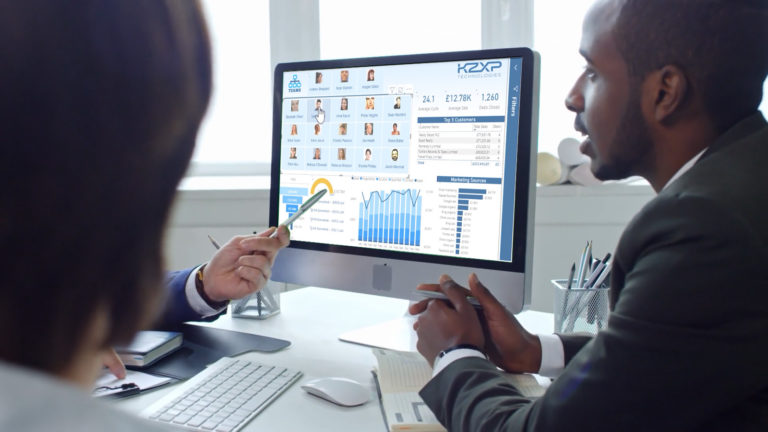Mastering the Art of Custom Tooltips in Power BI – Taking Data Visualization to the Next Level
Power BI has emerged as a powerful tool for data visualization, enabling users to analyze and present complex information effectively. One of the key features that sets Power BI apart is its ability to create custom tooltips, which take data visualization to the next level. In this article, we will explore how you can master the art of custom tooltips in Power BI and unleash the full potential of your data.
Introduction
Data visualization plays a crucial role in understanding and communicating insights from data. Power BI, with its intuitive interface and powerful capabilities, has become a popular choice for businesses and individuals alike. Custom tooltips in Power BI allow users to provide additional context and information about data points when interacting with visual elements. By leveraging custom tooltips effectively, you can enhance the user experience and convey insights more efficiently.
What are tooltips?
Tooltips are informative pop-up windows that appear when users hover over or click on specific elements in a visual. They provide supplementary information related to the data point under focus, offering a deeper understanding of the data without cluttering the main visual. In Power BI, tooltips can be customized to display specific details, visuals, or even related data.
Creating custom tooltips in Power BI
Creating custom tooltips in Power BI is a straightforward process that involves a few simple steps. First, you need to enable tooltips for a visual, and then you can define the content that appears in the tooltip. Power BI Desktop provides a user-friendly interface where you can configure and customize tooltips according to your requirements.
To create custom tooltips, follow these steps:
Select the visual for which you want to enable tooltips.
Go to the “Format” pane and find the “Tooltip” section.
Toggle the “Tooltip” option to “On.”
Define the content of the tooltip using the fields and visuals available.
Designing effective custom tooltips
While creating custom tooltips, it is essential to design them effectively to ensure they serve their purpose and engage the users. Here are some key considerations:
Choosing the right visuals for tooltips
Tooltips can contain various visuals such as charts, tables, images, or even custom visuals. Depending on the nature of your data and the insights you want to convey, you can choose the most appropriate visual for your tooltips. For example, if you are visualizing sales data, you can include a line chart in the tooltip to show the trend over time. Consider the type of information you want to highlight and select visuals that effectively communicate that information.
Formatting and styling options
Power BI offers a range of formatting and styling options to customize the appearance of tooltips. You can adjust the font size, color, and style to ensure readability and consistency with your overall visual design. Additionally, you can apply conditional formatting to highlight specific data points or add icons and images to make the tooltips visually appealing.
Adding interactivity and drill-through actions
Custom tooltips can provide interactive elements that allow users to explore the data further. You can incorporate drill-through actions, enabling users to navigate to related reports or pages for more detailed analysis. This interactivity enhances the user experience and empowers users to dive deeper into the insights provided by the tooltips.
Advanced tooltip techniques
Beyond the basic customization options, Power BI offers advanced techniques to make your tooltips even more powerful and dynamic.
Conditional formatting in tooltips
Conditional formatting allows you to change the appearance of tooltips based on specific conditions or data values. This technique enables you to emphasize important insights or highlight exceptions within the tooltip itself. By applying conditional formatting, you can draw attention to significant data points and guide users’ focus.
Dynamic tooltips based on user interactions
Power BI enables you to create dynamic tooltips that change based on user interactions. For example, you can include interactive buttons or slicers within the tooltip, allowing users to filter the data or switch between different views dynamically. This flexibility enhances the versatility of tooltips and enables users to explore the data from various perspectives without leaving the visual.
Incorporating tooltips with tooltips
Power BI allows you to nest tooltips within tooltips, creating multi-level interactions. This technique is particularly useful when dealing with complex data hierarchies or when you want to provide layered information. By nesting tooltips, you can progressively reveal more detailed insights as users delve deeper into the data, creating a guided and interactive experience.
Best practices for using custom tooltips
To ensure your custom tooltips are effective and user-friendly, consider the following best practices:
Keeping tooltips concise and informative
Tooltips should provide concise and relevant information without overwhelming the user. Keep the content of tooltips focused on the key insights and avoid including excessive details. Aim to strike a balance between providing valuable information and maintaining simplicity.
Ensuring accessibility and readability
Make sure that your tooltips are accessible to all users, including those with visual impairments or using assistive technologies. Use alt text for images, provide clear and descriptive labels for visuals, and ensure sufficient color contrast for text and visuals within the tooltips. This way, you can guarantee that all users can benefit from the information conveyed by the tooltips.
Testing and iterating tooltips for optimal user experience
Before finalizing your tooltips, test them with a diverse group of users to gather feedback and identify areas for improvement. Pay attention to how users interact with the tooltips, whether they find them intuitive, and if they provide valuable insights. Use this feedback to refine and iterate your tooltips, ensuring they deliver the intended impact and meet the users’ needs.
Examples and case studies
To better understand the potential of custom tooltips in Power BI, let’s explore a few examples and case studies:
Example 1: Sales Dashboard
In a sales dashboard, custom tooltips can be used to provide additional details about individual sales transactions. When users hover over a specific data point representing a sale, a custom tooltip can show the customer’s name, purchase date, products purchased, and total revenue. This allows users to quickly access essential information without cluttering the main visual.
Example 2: Financial Analysis
In a financial analysis dashboard, tooltips can provide contextual information about specific financial metrics. For instance, when users interact with a revenue chart, a custom tooltip can display the revenue breakdown by product category, highlight the top-performing products, and show the percentage growth compared to the previous period. This enables users to gain deeper insights into the factors driving revenue and make informed business decisions.
Case Study: Company XYZ
Company XYZ, a retail organization, implemented custom tooltips in their Power BI dashboards to enhance their sales analysis. By customizing tooltips for their product visuals, they provided additional information such as product descriptions, customer reviews, and stock availability. This enriched the user experience and empowered their sales team to make data-driven decisions on the fly. As a result, Company XYZ saw a significant improvement in their sales performance and customer satisfaction.
Tips for optimizing tooltip performance
While custom tooltips offer a wealth of possibilities, it’s important to optimize their performance to ensure smooth and efficient data visualization.
Reducing data and visual complexity
Tooltips should provide concise information without overwhelming the user with excessive data or visuals. Optimize tooltip performance by limiting the amount of data displayed and using lightweight visuals whenever possible. This helps maintain fast load times and ensures a smooth user experience, especially when dealing with large datasets.
Utilizing tooltips with large datasets
When working with large datasets, it’s crucial to consider the performance impact of tooltips. Instead of loading all the data for every tooltip, consider using interactive features such as drill-through actions or linked visuals to provide more detailed information on demand. This way, you can strike a balance between providing valuable insights and maintaining optimal performance.
Integrating tooltips with other Power BI features
Tooltips can be seamlessly integrated with other Power BI features to create a cohesive and interactive data visualization experience.
Tooltip interactions with filters and slicers
By linking tooltips to filters and slicers, you can create dynamic interactions that allow users to explore the data in more depth. For example, when a user selects a specific product category using a slicer, the tooltips can update to show relevant information only for that category. This level of interactivity enhances user engagement and enables focused data analysis.
Utilizing tooltips in drill-through actions
Drill-through actions in Power BI allow users to navigate from a summary visual to more detailed reports or pages. By incorporating tooltips within drill-through pages, you can provide contextual information about specific data points, guiding users in their exploration. This combination of drill-through actions and tooltips creates a seamless and informative data exploration experience.
Future trends and advancements in custom tooltips
As data visualization continues to evolve, custom tooltips are expected to undergo further advancements. Here are some future trends to watch out for:
AI-driven tooltips and smart suggestions
Artificial intelligence and machine learning algorithms can play a significant role in enhancing tooltips. AI-driven tooltips can automatically identify relevant insights, patterns, or anomalies within the data and present them to the users. Additionally, AI algorithms can provide smart suggestions on what type of information or visuals to include in the tooltips, based on the analysis of historical data and user behavior.
Predictive analytics and tooltips
Predictive analytics capabilities can be integrated with tooltips to offer users predictive insights. For example, tooltips can display forecasts, predictions, or recommendations based on the underlying data. This empowers users to make proactive decisions and take advantage of future opportunities.
Conclusion
Custom tooltips in Power BI provide a powerful means of enhancing data visualization and improving the user experience. By leveraging custom tooltips effectively, you can present information in a more engaging and informative way, enabling users to derive deeper insights from your data. Remember to follow best practices, design tooltips with the user in mind, and continuously iterate and improve based on user feedback. Mastering the art of custom tooltips in Power BI will take your data visualization to the next level, unlocking the true potential of your data and empowering users to make informed decisions. So, start exploring the possibilities of custom tooltips in Power BI and take your data visualization to new heights.
FAQs (Frequently Asked Questions)
Can I create custom tooltips for all visuals in Power BI?
Yes, you can enable custom tooltips for most visuals in Power BI. However, some visuals may have limitations on the type of content that can be included in the tooltips.
Do custom tooltips impact the performance of my Power BI reports?
Custom tooltips can have an impact on performance, especially when dealing with large datasets or complex visuals. It is important to optimize the content and design of tooltips to ensure optimal performance.
Can I customize the appearance of tooltips to match my branding?
Yes, Power BI provides formatting options that allow you to customize the appearance of tooltips, including font styles, colors, and background design. This enables you to align tooltips with your branding guidelines.
Are custom tooltips accessible to all users, including those with disabilities?
Power BI provides accessibility features to ensure that custom tooltips are accessible to all users. By following accessibility best practices, such as using alt text for images and providing clear labels, you can make your tooltips inclusive.
How can I gather user feedback on the effectiveness of my custom tooltips?
You can conduct user testing and gather feedback on your custom tooltips by involving a diverse group of users. This feedback will help you understand how users interact with the tooltips and identify areas for improvement.
Conclusion
Custom tooltips in Power BI offer a remarkable opportunity to elevate your data visualization and engage your audience on a deeper level. By leveraging the flexibility and customization options provided by Power BI, you can create informative and visually appealing tooltips that enhance the user experience. Remember to keep your tooltips concise, relevant, and visually appealing while optimizing their performance. With practice and iteration, you can master the art of custom tooltips in Power BI and unlock the full potential of your data storytelling.
















